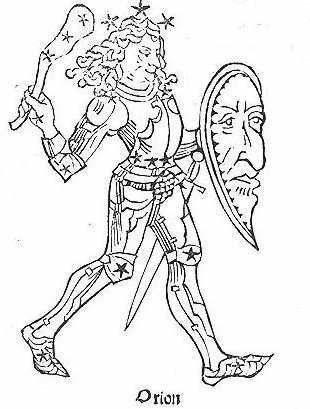|
1. Orion stands out against the background of the other constellations, and one aspect of this fact is that it does not belong in the string of zodiac figures:
In spite of its very bright and clear starry outline it is not in the 'band of life', determined by the ecliptic path of Sun. It is below the ecliptic but 'squarely' on the equator of the sky dome.
I have copied the precession picture above from Hamlet's Mill, where it adorns the endpaper of the book. In turn it was copied from Robert Eisler's The Royal Art of Astrology (not 'Astronomy' as it says in the list of illustrations). Instead of the outline on the star map above, with the Belt of Orion suggesting the narrow waist of a man, the Eisler illustration is more like the outline of a house, and we should remember my interpretation of the name Betelgeuze as the 'House of the Giant'. According to Hyginus (Poeticon, 1482) - I have copied this illustration from Linda Hall's site - Orion was a warrior:
Scattered information in Allen's book reveal, however, that Al Jauzah was a woman, e.g. where he informs us about Procyon: "We also find Al Jummaizā, their Sycamine, although some say that this should be Al Ghumaisā, the Dim, Watery-eyed, or Weeping One; either from the fact that her light was dimmer than that of her sister Al Shi'rā [Sirius], or from the fable connected with Suhail and his marriage to Al Jauzah and subsequent flight, followed by Al Shi'rā below the Milky Way, where she remained, the other sister, Al Ghumaisā, being left in tears in her accustomed position, or it may be from a recollection of the Euphratean title for Procyon, - the Water-dog. Bayer wrote the word Algomeiza; Riccioli, Algomisa and Algomiza; and others, Algomeysa, Algomyso, Alchamize, etc. Thus the Two Dog stars were the Arabs' Al Ahawāt al Suhail, the Sisters of Canopus. Still another derivation of the name is from Al Ghamūs, the Puppy; but this probably was a later idea from the Romans." Procyon is in the 8th hour and we should therefore not now discuss it any further. Sirius, though, will soon be on our agenda - and it can hardly be called a Water-dog, because it is the brightest star in the sky. The Water-dog, the minor one, is coming after the major one, Canis Majoris. |


